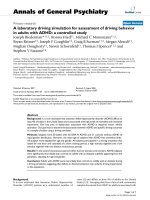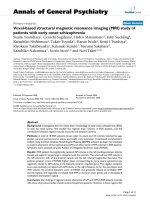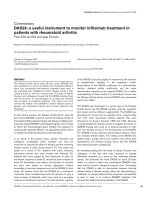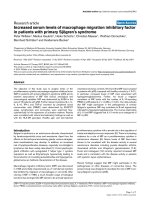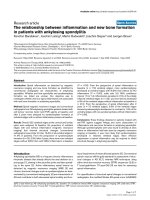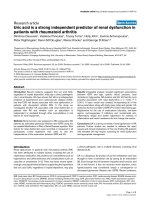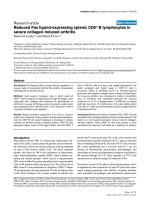Báo cáo y học: "DAS28: a useful instrument to monitor infliximab treatment in patients with rheumatoid arthritis" pps
Bạn đang xem bản rút gọn của tài liệu. Xem và tải ngay bản đầy đủ của tài liệu tại đây (34.14 KB, 2 trang )
189
DAS28 = Disease Activity Score using 28 joint counts; DMARD = disease-modifying anti-rheumatic drug.
Available online />Abstract
The Disease Activity Score using 28 joint counts (DAS28) has
been developed in a cohort of patients with rheumatoid arthritis in
which only conventional anti-rheumatic treatments were used. It
has extensively been validated to monitor disease activity in daily
clinical practice as well as in clinical trials. The study of Vander
Cruyssen and colleagues showed that the DAS28 correlated best
with the decisions of rheumatologists to increase the infliximab
dose because of insufficient response. This result once more
confirms the validity of the DAS28 to monitor disease activity in
patients with rheumatoid arthritis and to titrate treatment with
biologicals.
In daily clinical practice, the Disease Activity Score using 28
joint counts (DAS28) is used to monitor the disease activity of
rheumatoid arthritis patients treated with disease-modifying anti-
rheumatic drugs (DMARDs) and biological agents. This is useful
to inform the rheumatologist about whether the treatment is
producing the expected effects in an appropriate period of time
or whether the treatment should be more intensified.
In an article in the present issue, Vander Cruyssen and
colleagues investigated which variables can best be
measured to evaluate the effect of therapy and the remaining
disease activity in daily clinical practice [1]. This study was
based on a cohort of 511 patients with active refractory
rheumatoid arthritis who were treated with infliximab [2].
Patients who were judged by their physicians to have an
insufficient response at week 22 received a dose increase at
week 30. According to the authors, the decision to increase
the dose was based on clinical judgement, without
knowledge of outcome measures such as the DAS28. In their
study, the authors found that the DAS28 as a continuous
composite index correlated best with the decision to give a
dose increase of infliximab, which was used as a surrogate
measure of insufficient response. The discriminative capacity
of the DAS28 could only slightly be improved by the inclusion
of supplemental variables in the regression model.
Recalculation of the DAS28 coefficients in a discriminative
function obtained similar coefficients and the same
discriminative capacity as the original DAS28. For a better
understanding of these results, it is informative to know how
the Disease Activity Score and the DAS28 were developed
back in the 1990s.
The DAS28 was developed in a similar way to the Disease
Activity Score, but the DAS28 contains reduced, ungraded,
joint counts and has different weights [3,4]. The DAS28 was
developed in a cohort from an outpatient clinic, using the data
from 227 early rheumatoid arthritis patients that were
followed-up for 9 years between 1985 and 1994. Because
no gold standard for disease activity is available, decisions on
DMARD therapy were used as an external standard of ‘high’
and ‘low’ disease activity in the development of the DAS28.
The DAS28 formula optimally discriminated between these
two clinically relevant states. The validity of the DAS28 was
tested using a similar cohort from another clinic. Since their
development, the Disease Activity Score and the DAS28
have extensively been validated [5].
An interesting finding from the study of Vander Cruyssen and
colleagues is that they also used decisions to change
(infliximab) treatment as a proxy for the underlying disease
activity, and produced the same DAS28 as found 20 years
earlier in a cohort in which only conventional DMARDs were
used, without a need to change its content or form. This means
that the DAS28 is able to discriminate between clinically
relevant states of disease activity, rather than discriminating a
‘readiness’ to change treatment (from physicians and patients)
to start, to stop or to continue DMARD treatment. This
enforces the validity and generalisability of the DAS28.
Commentary
DAS28: a useful instrument to monitor infliximab treatment in
patients with rheumatoid arthritis
Piet LCM van Riel and Jaap Fransen
Department of Rheumatology, Radboud University Nijmegen Medical Centre, Nijmegen, The Netherlands
Corresponding author: Piet LCM van Riel,
Published: 22 August 2005 Arthritis Research & Therapy 2005, 7:189-190 (DOI 10.1186/ar1820)
This article is online at />© 2005 BioMed Central Ltd
See related research by Vander Cruyssen et al. in this issue [ />190
Arthritis Research & Therapy October 2005 Vol 7 No 5 van Riel and Fransen
The authors reached their conclusion based on a series of
analyses comparing the performance of multiple measures in
several ways. The authors used receiver-operating
characteristic curves and sensitivity, specificity and predictive
values to rank the measures in order of their performance. As
the authors state, these statistics for diagnostics may be
used to rank measures in a study, but it is difficult to
generalise the values for sensitivity, specificity, and so on,
beyond the study. This difficulty occurs because all values for
these statistics heavily depend on the distributions found in
the study (see Figure 1 in [1]). Moreover, the use of
sensitivity, specificity, and so on, does not reflect the way the
DAS28 is used, as one would not use the DAS28 to
‘diagnose’ physician opinion on whether or not to increase
the infliximab dose.
However, the results of Vander Cruyssen and colleagues can
best be understood when looking at Figure 1 in their article
[1], depicting the differences in disease activity measures
between both groups of patients. Two lessons can be
learned from this figure.
First, higher scores of the DAS28 and the other disease
activity measures are found in patients in which a decision
was made to increase the dose of infliximab. Only a few other
studies used external criteria for high and low disease activity
to study the validity of the Disease Activity Score and the
DAS28. In a study performed in Italy in the late 1990s, it was
found that the Disease Activity Score was the best measure
to discriminate between predefined states of low and high
disease activity, in a sample of 202 patients [6]. A recent
study used a different, opinion-based, approach, with expert
rating (n = 35) of a sample of clinical profiles that were
categorised into remission, low disease activity, moderate
disease activity and high disease activity [7]. Interestingly, the
cut-off criteria for the DAS28 that were found in this way
were only slightly different from the established cut-off points
for the DAS28, which can therefore be regarded as
confirmation.
The second interesting finding from Vander Cruyssen and
colleagues’ study, which was not highlighted in the article, is
that more than 50% of the patients in which the infliximab
dose was not increased had DAS28 > 3.2, which means
‘moderate’ or ‘high’ disease activity. One may ask whether a
dose increase would also have been indicated in these
patients, as the aim is to reach low disease activity or even
remission. This illustrates that the target of anti-rheumatic
treatment is moving in time. It is therefore an extra advantage
to use a continuous measure with absolute values to measure
disease activity in daily clinical practice and clinical trials.
Conclusion
The study of Vander Cruyssen and colleagues confirms that
the DAS28 is a valid measure to monitor disease activity and
to titrate treatment with biologicals [8].
Competing interests
The author(s) declare that they have no competing interests.
References
1. Vander Cruyssen B, Van Looy S, Wyns B, Westhovens R, Durez
P, Van den Bosch F, Veys EM, Mielants H, De Clerck L, Peretz A,
et al.: DAS28 reflects best the physician’s clinical judgement
of response to infliximab therapy in rheumatoid arthritis
patients: validation of the DAS28 score in patients under
infliximab treatment. Arthritis Res Ther 2005, 7:R1063-R1071.
2. Durez P, Van den Bosch F, Corluy L, Veijs EM, De Clerck L,
Peretz A, Malaise M, Devogelaer JP, Vastesaeger N, Geldhof A, et
al.: A dose adjustment in patients with rheumatoid arthritis
not optimally responding to a standard dose of infliximab of 3
mg/kg every 8 weeks can be effective: a Belgian prospective
study. Rheumatology 2005, 44:465-468.
3. Heijde van der DMFM, Hof van ‘t MA, Riel van PLCM, Theunisse
HAM, Lubberts EW, Leeuwen van MA, Rijswijk van MH, Putte van
de LBA: Judging disease activity in clinical practice in rheuma-
toid arthritis. First step in the development of a ‘disease activ-
ity score’. Ann Rheum Dis 1990; 49:916-920.
4. Prevoo MLL, Hof van ‘t MA, Kuper HH, Leeuwen van MA, Putte
van de LBA, Riel van PLCM: Modified disease activity scores
that include twenty-eight-joint counts: development and vali-
dation in a prospective longitudinal study of patients with
rheumatoid arthritis. Arthritis Rheum 1995, 38:44-48.
5. Fransen J, Stucki G, Riel van PLCM: Rheumatoid arthritis mea-
sures. Arthritis Rheum (Arthritis Care Res) 2003, 49:214-224.
6. Salafi F, Peroni M, Ferraccioli GF: Discriminative ability of com-
posite indices for measuring disease activity in rheumatoid
arthritis: a comparison of the Chronic Arthritis Systemic index,
Disease Activity Score and Thompson’s Articular Index.
Rheumatology 2000, 39:90-96.
7. Aletaha D, Ward M, Machold K, Nell VPK, Stamm T, Smolen JS:
Remission and active disease in rheumatoid arthritis: defining
criteria for disease activity states [abstract 0346]. Ann Rheum
Dis 2005, 64(Suppl III):214.
8. Broeder den AA, Creemers MCW, Gestel van AM, Riel van
PLCM: Dose titration using the Disease Activity Score
(DAS28) in rheumatoid arthritis patients treated with anti
TNF-
αα
. Rheumatology 2002, 41:638-642.


